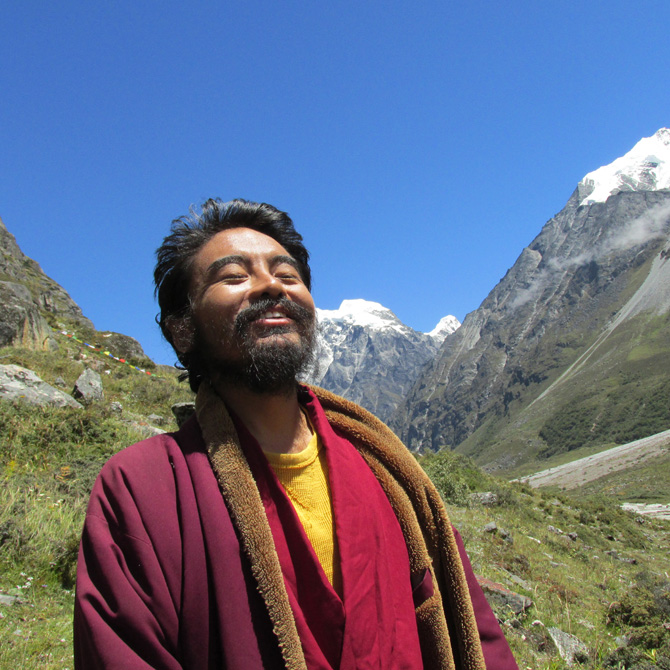In the serene and contemplative world of Tibetan Buddhism, the practice of retreat holds a place of profound significance. More than just a temporary escape from the hustle and bustle of daily life, retreat is considered a powerful and essential method for cultivating inner peace, wisdom, and ultimately, liberation. This sentiment was beautifully articulated in a recent talk by His Eminence Yongey Mingyur Rinpoche, offering insightful perspectives on why this solitary practice is so deeply valued.
Mingyur Rinpoche shared a personal connection to retreat, recalling a deep inner yearning to engage in this practice from a young age. This wasn’t a mandated duty but rather a heartfelt inclination, almost a personal passion. This early desire highlights a fundamental aspect of retreat: it often stems from an intrinsic motivation to deepen one’s spiritual journey.
Historically, the Tibetan Buddhist tradition is replete with examples of great masters who dedicated significant portions of their lives to retreat. Some even spent half of their early years in solitary practice before emerging to benefit countless others. This underscores a core principle: “first, liberate yourself.” The wisdom gained and the negative emotions purified through dedicated retreat form a solid foundation for genuinely helping others achieve their own liberation, true wisdom, and compassion.
The example of the Buddha himself serves as a powerful illustration. Before attaining enlightenment, Siddhartha Gautama spent six years in intensive retreat near the river Niranjana. This period of focused practice was the crucible in which he transformed into the Buddha. Similarly, the revered Milarepa is known for his extensive retreats, initially for twelve rigorous years, followed by a life largely spent in solitary practice. These stories are not mere legends; they highlight the transformative potential inherent in dedicated retreat.
But why is retreat so crucial? Mingyur Rinpoche illuminated three primary causes for negative emotions, bad karma, and suffering. Understanding these causes reveals the inherent value of the retreat environment:
- The Object is Nearby: Our attachments and aversions are often intensified by the constant presence of their objects. If someone triggers your anger or something ignites your desire, repeated exposure fuels these emotions. Retreat removes this immediate external stimulus, providing a space free from these direct triggers.
- Not Abandoning the Root of Negative Emotions (Ego): Unless the fundamental root of ego and negative emotions is severed through deep realization, these afflictions will inevitably arise when their objects are present. While a high level of realization can transcend these triggers even in daily life, retreat offers an undisturbed environment to actively work on uprooting these deeply ingrained tendencies.
- Having Wrong Motivation: Even when external triggers are present and the root of ego remains, harmful actions can be avoided with wholesome motivation. However, when negative motivation aligns with external stimuli and an unaddressed ego, the conditions for negative karma are ripe. Retreat fosters introspection and cultivates positive motivation, weakening the power of harmful intentions.
The very nature of retreat – solitude, removed from the distractions of mundane life – directly addresses the first cause. By closing the door to the external world, practitioners gain uninterrupted time and space for focused practice. This dedicated time allows for deeper exploration of the inner landscape, fostering the conditions necessary for genuine spiritual development.
It’s important to note that Mingyur Rinpoche wasn’t suggesting that retreat is the only path to realization or that those not in retreat are not true Buddhists. Rather, the emphasis was on its profound benefits. Ultimately, the purpose of retreat extends beyond personal liberation. The deeper experiences and realizations gained in solitude equip practitioners with greater wisdom and compassion to share with the world, offering more profound and meaningful support to others on their own paths.
Mingyur Rinpoche’s personal history, with numerous retreats undertaken in Sherabling, lends a heartfelt authenticity to the message. It underscores the enduring value placed on this ancient practice within the Tibetan Buddhist tradition – a powerful means of cultivating inner transformation for the benefit of oneself and all beings.
Yongey Mingyur Rinpoche is a Tibetan teacher and master of the Karma Kagyu and Nyingma lineages of Tibetan Buddhism. He has written five books and oversees the Tergar Meditation Community, an international network of Buddhist meditation centers.
Discover the Transformative Power of Solitude: Your Own Retreat Inspired by the Tibetan Tradition
Inspired by the profound wisdom shared by Mingyur Rinpoche and the rich history of retreat in Tibetan Buddhism, Bodhicitta Retreat Centre offers you the opportunity to experience your own self-led meditation retreat. Just as the great masters and even the Buddha himself sought periods of solitude for deep practice, you too can benefit from stepping away from the demands of daily life.
At Bodhicitta Suan Phueng in Thailand, we provide a supportive environment for your inner exploration, featuring:
- Comfortable and peaceful accommodation, allowing for focused introspection.
- Nourishing vegetarian meals, sustaining your body and mind during your practice.
- Flexible durations, from a short two-night immersion to more extended periods of dedicated retreat, allowing you to tailor the experience to your needs and intentions.
- A serene natural setting, a tranquil escape just two hours from Bangkok, minimizing external distractions and fostering inner calm.
- Convenient airport transfers, ensuring a smooth and stress-free arrival and departure, so you can focus entirely on your retreat.
Discover the transformative potential of solitude and cultivate your own inner wisdom and compassion, drawing inspiration from the enduring tradition of Buddhist retreat.
Book your retreat online today.
Images and videos on this blog post are subject to copyright by Tergar.
